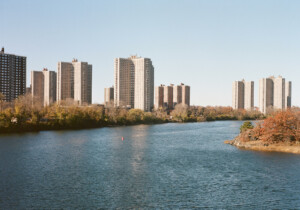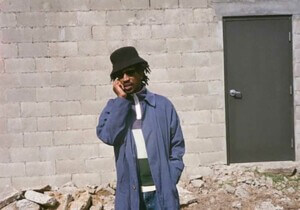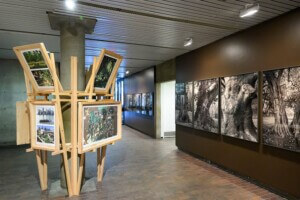Up in the Air
Whitney Museum of American Art
Through February 9, 2014
Circles and squares; past and present; inside and outside. These are some of the elements that combine architecture and the moving image in T.J. Wilcox’s Up in the Air, a contemporary cyclorama of his Union Square penthouse studio view installed in Marcel Breuer’s Whitney Museum building.
The circle is the ringed screen—7 feet tall and 35 feet in circumference—that you must bend under to enter the inner circle. Suspended only 6 feet below the museum’s distinctive coffered ceilings that are the squares, as is the room’s shape, it is intentionally hung close to respond to the masonry “frames.”
The moving-image narrative on the circular screen is a single sunny summer day and clear night shot from his downtown aerie where we can see the Empire State Building, Zeckendorf Towers, Con Edison Building, and One World Trade Center amongst water towers, cranes, and satellite dishes in the correct orientation (north is north, south is south) representing the present. Wilcox says we bend these current vistas to our own associations, prompting memories of the past. He has provided us with five narrative reflections that spool out one by one: the Hindenburg crash and planned zeppelin mooring docks atop the Empire State Building; the court battle for custody of little Gloria Vanderbilt by her aunt Gertrude, founder of the Whitney Museum; fashion illustrator and AIDS victim Antonio Lopez, who occupied a studio directly across the square from Wilcox’s and whose work inspired him to move to New York; Warhol inflating silver balloons to commemorate Pope Paul IV’s New York visit in 1965; and the building’s super who observed the World Trade Center attacks from this rooftop which morphs into Manhattan-henge, the day when sunset aligns along the NYC street grid facing west.
These chapters embody Wilcox’s exercise in looking across time simultaneously. Simultaneity is also how the mechanics work, with ten projectors working together linked by a single computer processor that compensates for the curvature of the screen. Five cameras shot 60,000 individually processed still images at a rate of one per second for better resolution than conventional video. Because the viewpoint is above street level without cars and pedestrians, the effect is a timeless cityscape.
You can experience Up in the Air from outside the perimeter of the circle, where it’s like a giant lantern, or from the inside where you are enveloped in an immersive pool of light and images. The way we view these buildings and the stories they tell are from both sides, too. Wilcox says that history is always under construction.










